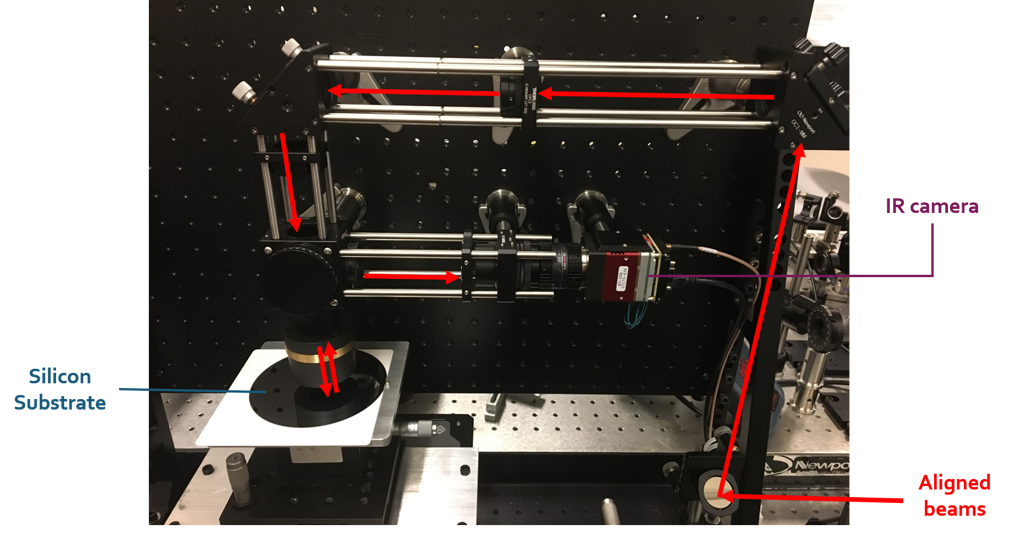About
20 October 2022
New way to make telescope mirrors could sharpen our view of the universe
Femtosecond lasers used to fabricate precision ultrathin mirrors for space telescopes that capture star formation and other high-energy space events
WASHINGTON — Researchers have developed a new way to use femtosecond laser pulses to fabricate the high-precision ultrathin mirrors required for high-performance x-ray telescopes. The technique could help improve the space-based x-ray telescopes used to capture high-energy cosmic events involved in forming new stars and supermassive black holes.

Caption: Researchers developed a new way to use femtosecond laser pulses to fabricate the high-precision ultrathin mirrors required for high-performance x-ray telescopes. Femtosecond laser surface ablation is applied to selectively remove stressed film regions on the mirror substrate, correcting the shape of the mirror’s reflective surface.
Image Credit: Heng Zuo, MIT Kavli Institute for Astrophysics and Space Research
“Detecting cosmic x-rays is a crucial piece of our exploration of the universe that unveils the high-energy events that permeate our universe but are not observable in other wavebands,” said research team leader Heng Zuo, who performed the research at MIT Kavli Institute for Astrophysics and Space Research and is now at the University of New Mexico. “The technologies our group developed will help telescopes obtain sharp images of astronomical x-rays that can answer many intriguing science questions.”
X-ray telescopes orbit above the Earth’s atmosphere and contain thousands of thin mirrors that must each have a precisely curved shape and be carefully aligned with respect to all the other mirrors. In Optica, Optica Publishing Group’s journal for high-impact research, the researchers describe how they used femtosecond laser micromachining to bend these ultrathin mirrors into a precise shape and correct errors that can arise in the fabrication process.
“It is difficult to make ultra-thin mirrors with an exact shape because the fabrication process tends to severely bend the thin material,” said Zuo. “Also, telescope mirrors are usually coated to increase reflectivity, and these coatings typically deform the mirrors further. Our techniques can address both challenges.”
Precision bending
New ways to fabricate ultra-precise and high-performance x-ray mirrors for telescopes are needed as new mission concepts continue to push the limits of x-ray imaging. For example, NASA’s Lynx X-ray Surveyor concept will have the most powerful x-ray optic ever conceived and will require the manufacture of a large number of ultra-high-resolution mirrors.
To meet this need, Zuo’s research group combined femtosecond laser micromachining with a previously developed technique called stress-based figure correction. Stress-based figure correction exploits the bendability of thin mirrors by applying a deformable film to the mirror substrate to adjust its stress states and induce controlled bending.
The technique involves selectively removing regions of a stressed film grown onto the back surface of a flat mirror. The researchers selected femtosecond lasers to accomplish this because the pulses produced by these lasers can create extremely precise holes, channels and marks with little collateral damage. Also, the high repetition rates of these lasers allow faster machining speeds and throughput compared to traditional methods. This could help speed up fabrication for the large numbers of ultra-thin mirrors required for next-generation x-ray telescopes.
Mapping stress

Caption: Zuo’s research group combined femtosecond laser micromachining with a previously developed technique called stress-based figure correction. The experimental setup is shown.
Image Credit: Heng Zuo, MIT Kavli Institute for Astrophysics and Space Research
To carry out the new approach the researchers first had to determine exactly how laser micromachining changes the mirror’s surface curvature and stress states. Then they measured the initial mirror shape and created a map of the stress correction necessary to create the desired shape. They also developed a multi-pass correction scheme that uses a feedback loop to repeatedly reduce errors until an acceptable mirror profile is achieved.
“Our experimental results showed that patterned removal of periodic holes leads to equibiaxial (bowl-shaped) stress states, while fine-pitched oriented removal of periodic troughs generates non-equibiaxial (potato-chip-shaped) stress components,” said Zuo. “Combining these two features with proper rotation of the trough orientation we can create a variety of stress states that can, in principle, be used to correct for any type of error in the mirrors.”
In this work, the researchers demonstrated the new technique on flat silicon wafers using regular patterns. To correct real x-ray astronomy telescope mirrors, which are curved in two directions, the researchers are developing a more complex optical setup for 3D movement of the substrates.
Paper: H. Zuo, R. Heilmann, M. Schattenburg, “Femtosecond laser micromachining for stress-based figure correction of thin mirrors,” Vol. 9, Issue 10, pp. 1163-1175 (2022) https://doi.org/10.1364/OPTICA.461870
About Optica Publishing Group
Optica Publishing Group is a division of the society, Optica, Advancing Optics and Photonics Worldwide. It publishes the largest collection of peer-reviewed and most-cited content in optics and photonics, including 18 prestigious journals, the society’s flagship member magazine, and papers and videos from more than 835 conferences. With over 400,000 journal articles, conference papers and videos to search, discover and access, our publications portfolio represents the full range of research in the field from around the globe.
About Optica
Optica is an open-access journal dedicated to the rapid dissemination of high-impact peer-reviewed research across the entire spectrum of optics and photonics. Published monthly by Optica Publishing Group, the Journal provides a forum for pioneering research to be swiftly accessed by the international community, whether that research is theoretical or experimental, fundamental or applied. Optica maintains a distinguished editorial board of more than 60 associate editors from around the world and is overseen by Editor-in-Chief Prem Kumar, Northwestern University, USA. For more information, visit Optica.
Media Contact
